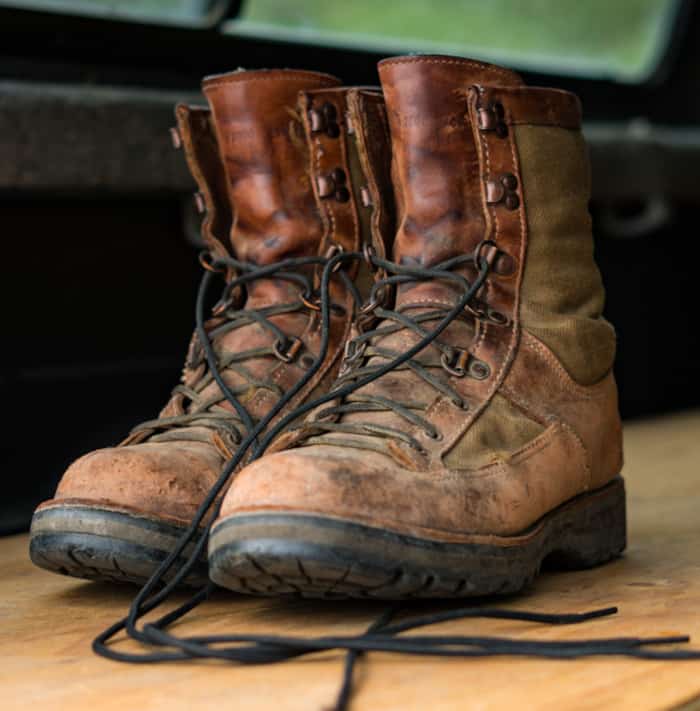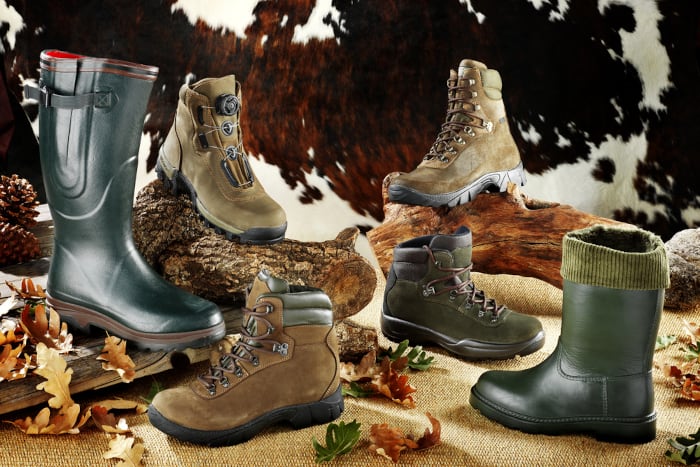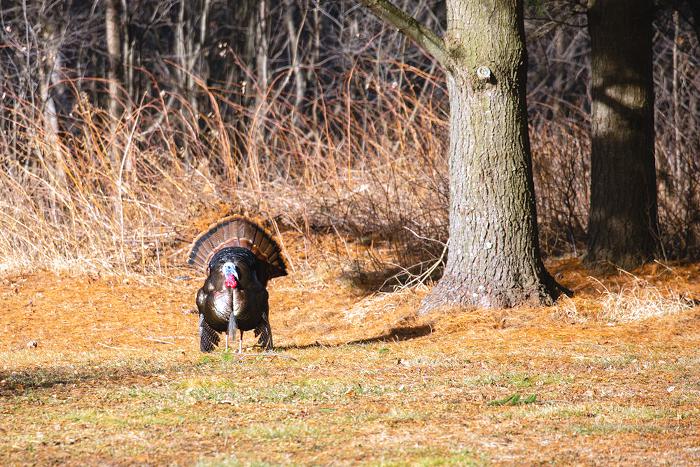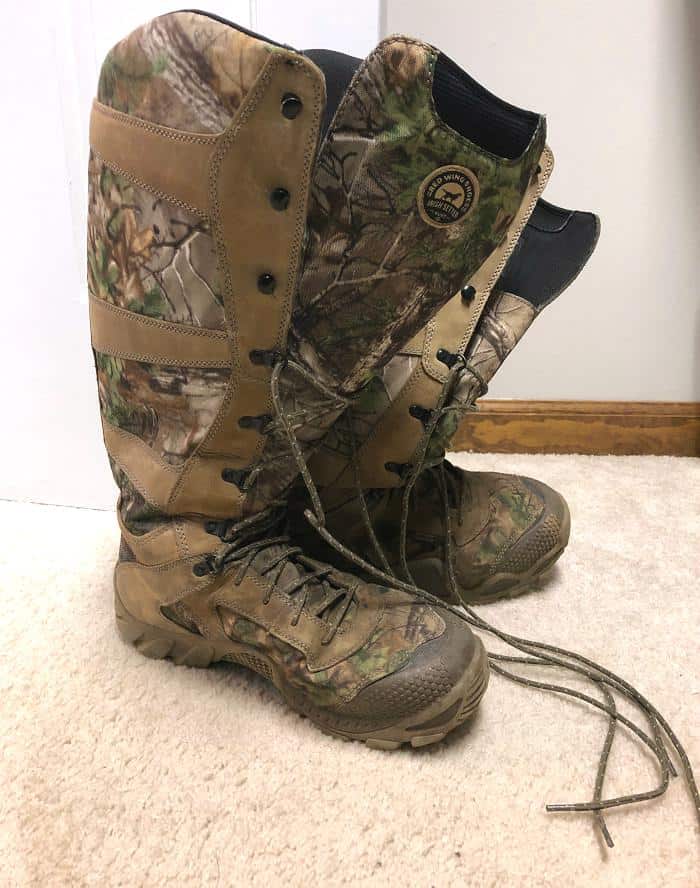Have you ever been shopping for hunting boots and noticed that they were labeled as featuring Thinsulate™ insulation? Most boot shoppers don’t really know all that much about this form of insulation so here’s a look at answering the following question: What is Thinsulate in hunting boots, and why is it so effective?

Thinsulate™ is a type of synthetic insulation created and trademarked by the 3M Corporation. It first entered the market in 1979 and has become the standard material for boot insulation.
The “Thinsulate” phrase is a play on the words “insulate” and “thin” and is trademarked by 3M. When Thinsulate™ insulation was first introduced, 3M was marketing it as a lighter and less expensive insulation alternative to down insulation. However, instead of a down material replacement, Thinsulate™ gained better traction as an insulation product across a variety of markets, including:
- Clothing (especially footwear)
- Automotive
- Airplanes
- Commercial construction
Thinsulate™ insulation is highly effective due to its super small fiber size. Typical Thinsulate™ fibers are about 15 micrometers in diameter, which is about twice as small as polyester. Although smaller and lighter, Thinsulate fibers are denser and significantly thinner than polyester. However, there are several other synthetic insulation materials on the market, including:
- Primaloft
- Heatseeker
- Zylet
Of those three Thinsulate alternatives, Primaloft is the best known and closest competitor to Thinsulate.
Being so thin, Thinsulate fibers can be woven more closely together, reducing the flow of heat away from the body and allowing moisture to escape and evaporate. Plus, Thinsulate helps trap air molecules
Thinsulate™ has become the industry standard for thermal insulation, and is recognized as one of the warmest thin apparel insulation products on the market. Thinsulate™ is commonly used as a thin insualtion material in the following products:
- Winter gloves (commonly called Thinsulate gloves)
- Winter jackets
- Outdoor clothing
- Boots
The insulation properties mentioned above make Thinsulate™ the market-leading choice for boot insulation. In addition, Thinsulate can be woven into the boot membrane without adding any significant bulk or weight.
Thinsulate™ is usually listed in boots by the gram and can range from 200 to 3000 grams. The lower the amount of Thinsulate, the less insulation the boot possesses. Conversely, higher amounts of Thinsulate provide more insulation and warmth for colder weather.
Understanding How Thinsulate is Measured
The number of grams of Thinsulate refers to the thickness of the boot insulation, not the overall volume of insulation in the boots. This number is determined by the weight of one square meter of the Thinsulate material. So, a pair of hunting boots with 400 grams of Thinsulate insulation does not have 400 grams worth of insulation in each boot.
As the numerical ratings of Thinsulate increase, the insulation level also increases because of the thickness of the Thinsulate material increases.
I’ve seen and heard hunters say that a boot with 600 grams of Thinsulate has 600 grams of the material in each boot, but that information is not entirely correct.

How much Thinsulate in boots is enough?
The answer to that question is tied to several factors, including the following:
- The expected outdoor temperatures that you’ll be exposed to
- The length of time of the exposure
- The level of activity while the boots are worn
- Your own individual levels of cold tolerance
Since boots are available in many different levels of 3M Thinsulate, let’s take a quick look at some of the common groups of boot insulation and the typical outdoor conditions and temperature rating for each level. Keep in mind that these ratings and examples are just high-level explanations designed to help explain the differences and different situations where each Thinsulate level might be applicable:
Uninsulated Boots
Uninsulated boots are manufactured without any insulation against the cold. This style of boot is best suited for warm weather hiking or hunting. If you used some heavy-duty wool socks, you could probably use them for hunting in mild to moderate temperatures above 70 degrees.
200 Gram Boots
As the name implies, these boots are built with 200 grams of Thinsulate insulation. This boot style is best for use on mild, cool days where the morning has temperatures in the mid 50’s up to the 70-degree range.
400 Gram Boots
The 400-gram boots are an extremely popular configuration as they are highly versatile. Worn with thin socks, a pair of 400-gram boots can be worn for warmer temperatures in the 40 to 60 degrees range. Or, when worn with thick socks, they can be used in cooler temperatures in the 30 to 50-degree range, with little to no activity. They are an ideal level of insulation for cool mornings that change over to warm mid-mornings.
In addition, the 400 gram Thinsulate insulation level is prevalent for work boots as they don’t overheat when working or being active in mild to warmer conditions.
600 Gram Boots
Boots constructed with 600 grams of Thinsulate are ideal for use in situations where the temperature range is 30 degrees to 50 degrees but changes very slowly throughout the day. For example, a day where the morning starts at 30 degrees, reaches 50 by 2 PM, then begins to drop back down.
Like most boots, the 600-gram models can be used as a cold-weather boot but perform best when the cold weather exposure is limited to a few hours. The 600-gram models are also very popular as work boots in cold weather scenarios with heavy physical activity.
Quick story: I was taking a trip up north to hunt in early winter, and the forecast was calling for warmer than average temperatures during the hunt. Based on that information, I opted to pack my favorite pair of 600-gram hunting boots and a few thick pairs of socks in case the temperature changed.
Well, the temperature changed and dropped into the teens for early morning, with a daily high of 30-35 degrees. Even with several pairs of layered socks, my feet froze sitting in a deer stand. The 600-gram boots were just insufficient insulation for those temperatures and a stationary position. Lesson learned. These days, I usually pack two pairs of boots on trips: one for “expected” weather and a pair with more insulation for “unexpected” weather.
800 Gram Boot
Boots with 800 grams of Thinsulate are cold-weather boots best suited for colder temperatures in the 30 to 40-degree range with little to no activity (such as sitting in a deer stand). This is also a good starting point for boots that work in light to moderate snow, as long as the boots are waterproof. With a good quality pair of heavy-duty socks, you may be able to make 800-gram boots work in temperatures slightly under 30 degrees for a short duration.
800-gram hunting boots are my go-to size in cold weather without standing snow. However, if standing snow is involved, I usually migrate up to 1200-gram boots because standing snow really cools down boots quickly.
1000 Gram Boots
Some boot manufacturers offer models with 1000 grams of Thinsulate, while some brands skip the 1000 gram option and move directly to 1200 grams.
One thousand gram boots will work for temperatures in the 10 to 30-degree range, but a heavy pair of socks could increase the temperature coverage down to 0 degrees.
1200 Gram Boots
As mentioned previously, 1200-gram hunting boots are my preferred level of insulation for hunting in the snow or hunting in temperatures ranging from 0 to 30 degrees.
A key point with 1200-gram boots is to make sure they are waterproof. If they aren’t waterproof or are rated as “water-resistant,” they won’t keep your feet dry in the snow for long.
Something else to be aware of: as you increase the level of Thinsulate grams, you also slightly increase the weight of the boots. The difference in weight can be significant too. For example, a set of boots in 1200 grams can weigh as much as 1 to 1.2 pounds more than a set of 600-gram boots.
Another pound of weight probably doesn’t sound like much, but it can feel like 10 pounds after hiking five miles in the snow.
1400 – 1600 Gram Boots
Some boot makers offer hunting boots with Thinsulate insulation in the 1400 grams to 1600 grams range.
Boots with that level of Thinsulate will work for very cold scenarios with temperatures in the 10 to the sub-zero range with some level of activity. However, the heavier 2000-gram boots may be a better option in sub-zero temperatures with a low activity level.
2000 Gram Boots
Hunting boots with 2000 grams of Thinsulate are built for frigid weather with temperatures at or under 0 degrees. In addition, this type of boot is made for use in heavy snow, so they are also fully waterproof.
However, as mentioned before, boots with this level of insulation are bulky and heavy. So, at first, they take a bit of getting used to.

What’s the Optimum Amount of Thinsulate Insulation for Your Needs?
That’s a challenging question to answer as many variables are involved. In addition, a single pair of hunting boots may not be ideal for every hunting situation.
For example, I use three pairs of hunting boots:
Uninsulated Snake Boots – I use these for early season hunts when it’s warm and venomous snakes are still out. I’d much rather spend $150 on a pair of snake boots versus thousands of dollars on snake bite treatment and medical costs.
600-gram Boots – When the weather cools down and venomous snakes are less common, I transition to a pair of 600-gram Thinsulate hunting boots. I find 600 grams to be cool enough for cooler weather hunting yet warm enough (especially when paired with warm socks) to work for colder weather hunting when the temps are in the 25 to 40-degree range.
1200 gram Boots – When winter weather sets in and the temperature drop below 25 degrees, or when I travel to hunt in icy conditions, I switch over to my favorite pair of boots that are insulated with 1200 grams of insulation.
Since I mostly live and hunt in the SE part of the U.S., I typically wear 600-gram boots the most in a hunting season.
FAQS
How do I know what level of Thinsulate are in my boots?
If the boots are brand new and still in the box, the Thinsulate level will be marked on the box. If you don’t have the original box, look inside the tongue of the boot, as most boot brands use a label that identifies the size and level of Thinsulate.
What are Thinsulate boot liners?
Thinsulate boot liners are a type of extra boot liner that can be purchased to add additional insulation levels to a pair of boots. In addition to offering additional warmth, some aftermarket boot liners are waterproof, adding an extra level of waterproofing to an existing pair of boots.
As expected, boot liners are manufactured from different materials, including Thinsulate, Primaloft, quilted foam, felt, and wool. The models manufactured from Thinsulate are called “Thinsulate boot liners.”
In addition to adding warmth and additional waterproofing (in some cases), boot liners also help extend the life of the boot over time.
What does Thinsulate mean in boots?
Thinsulate is an artificial insulation material commonly used in boots due to its weight-to-warmth ratio. Thinsulate is not the only insulation material used in boots but is the most common. The higher the grams of Thinsulate per gram per boot, the warmer the boots will be.

Born and raised in the North Carolina foothills, Andy was introduced to the outdoors at a very young age. Like most beginning hunters, he started out hunting small game like rabbits and squirrels, then graduated to larger species like Whitetail Deer. Although he’s an avid deer and turkey hunter, he still enjoys hunting small game as well. Andy has worked in the hunting and fishing industry for nearly 25 years.





